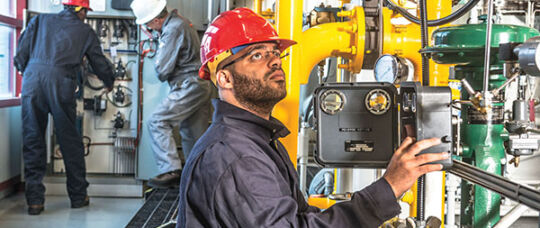The Facts About Roar Solutions Uncovered
The Facts About Roar Solutions Uncovered
Blog Article
The Best Strategy To Use For Roar Solutions
Table of ContentsHow Roar Solutions can Save You Time, Stress, and Money.The 9-Second Trick For Roar SolutionsIndicators on Roar Solutions You Should Know
In such an ambience a fire or surge is possible when three basic problems are satisfied. This is often referred to as the "hazardous location" or "burning" triangle. In order to secure setups from a potential explosion an approach of evaluating and identifying a possibly hazardous area is called for. The objective of this is to make certain the appropriate option and installment of devices to inevitably avoid a surge and to make certain safety and security of life.
(https://letterboxd.com/roarsolutions/)
No tools should be installed where the surface temperature level of the tools is above the ignition temperature level of the offered threat. Below are some common dust dangerous and their minimum ignition temperature level. Coal Dirt 380C 225C Polythene 420C (melts) Methyl Cellulose 420C 320C Starch 460C 435C Flour 490C 340C Sugar 490C 460C Grain Dirt 510C 300C Phenolic Material 530C > 450C Aluminium 590C > 450C PVC 700C > 450C Residue 810C 570C The likelihood of the risk being existing in a focus high adequate to create an ignition will certainly vary from place to location.
In order to categorize this risk an installment is divided into areas of danger depending upon the quantity of time the dangerous exists. These areas are described as Zones. For gases and vapours and dusts and fibers there are three zones. Zone 0 Area 20 A harmful atmosphere is very likely to be existing and may be present for extended periods of time (> 1000 hours per year) and even continuously Zone 1 Area 21 An unsafe atmosphere is feasible but not likely to be existing for lengthy durations of time (> 10 450 C [842 F] A classification of T6 implies the minimal ignition temperature level is > 85 C [185 F] Harmful area electrical devices perhaps designed for usage in higher ambient temperature levels. This would indicated on the ranking plate e.g. EExe II C T3 Ta + 60C( This means at 60C ambient T3 will certainly not be surpassed) T1 T1, T2, T3, T4, T5, T6 T2 T2, T3, T4, T5, T6 T3 T3, T4, T5, T6 T4 T4, T5, T6 T5 T5, T6 T6 T6 A T Course ranking of T1 implies the maximum surface temperature level produced by the instrument at 40 C is 450 C. Thinking the connected T Class and Temperature rating for the tools are suitable for the location, you can always make use of an instrument with a more rigorous Department ranking than required for the area. There isn't a clear response to this question unfortunately. It really does depend upon the sort of equipment and what repair work need to be performed. Devices with details examination treatments that can't be executed in the field in order to achieve/maintain 3rd party score. Should return to the manufacturing facility if it is prior to the equipment's solution. Area Repair Work By Authorised Personnel: Difficult testing may not be needed nonetheless specific treatments might require to be followed in order for the devices to maintain its 3rd party ranking. Authorised personnel should be employed to carry out the job correctly Repair service have to be a like for like substitute. New part need to be taken into consideration as a direct replacement requiring no unique screening of the devices after the repair service is full. Each item of tools with an unsafe rating ought to be assessed individually. These are outlined at a high level below, however for even more in-depth info, please refer straight to the standards.
Getting The Roar Solutions To Work
The equipment register is a comprehensive data source of equipment records that includes a minimum collection of areas to recognize each item's area, technical parameters, Ex lover classification, age, and ecological data. This details is essential for tracking and handling the tools efficiently within hazardous locations. On the other hand, for routine or RBI sampling evaluations, the grade will be a mix of Comprehensive and Close evaluations. The proportion of Comprehensive to Shut examinations will certainly be determined by the Devices Danger, which is assessed based upon ignition danger (the chance of a source of ignition versus the probability of a flammable ambience )and the harmful location classification
( Zone 0, 1, or 2). This variation will certainly also influence the resourcing requirements for work prep work. Once Whole lots are specified, you can create tasting strategies based upon the sample size of each Great deal, which describes the number of random equipment products to be checked. To establish the required sample size, two elements require to be reviewed: the dimension of the Whole lot and the classification of evaluation, which shows the degree of initiative that need to be used( reduced, normal, or increased )to the evaluation of the Great deal. By integrating the classification of assessment with the Whole lot dimension, you can then develop the proper denial criteria for a sample, implying the allowable variety of malfunctioning products discovered within that sample. For more information on this procedure, please refer to the Energy Institute Guidelines. The IEC 60079 common recommends that the optimum period in between inspections should not go beyond three years. EEHA assessments will also be conducted outside of RBI projects as component of arranged upkeep and tools overhauls or repair services. These inspections can be credited toward the RBI example dimensions within the impacted Lots. EEHA inspections are performed to recognize faults in electric devices. A heavy scoring system is important, as a solitary tool might have multiple mistakes, each with varying levels of ignition risk. If the combined rating of both evaluations is much less than two times the fault rating, the Whole lot is considered acceptable. If the Lot is still considered undesirable, it should undergo a complete assessment or justification, which may trigger stricter examination protocols. Accepted Whole lot: The causes of any kind of mistakes are recognized. If a common failure mode is located, extra tools may require examination and repair work. Faults are classified by intensity( Safety, Honesty, Housekeeping ), making certain that immediate issues are analyzed and addressed without delay to reduce any type of influence on safety or operations. The EEHA data source should track and record the lifecycle of mistakes in addition to more info here the restorative activities taken. Implementing a robust Risk-Based Examination( RBI )method is crucial for ensuring conformity and safety and security in handling Electrical Devices in Hazardous Locations( EEHA) (electrical refresher course). Automated Mistake Rating and Lifecycle Management: Effortlessly handle mistakes and track their lifecycle to boost examination accuracy. The intro of this support for risk-based assessment further strengthens Inspectivity's setting as a best-in-class service for regulative conformity, along with for any kind of asset-centric inspection use instance. If you have an interest in finding out more, we invite you to request a presentation and find exactly how our service can change your EEHA administration procedures.
3 Easy Facts About Roar Solutions Described

In terms of explosive threat, a harmful location is an environment in which an eruptive ambience is existing (or might be anticipated to be existing) in quantities that call for unique safety measures for the building and construction, setup and use tools. eeha certificate. In this article we discover the obstacles faced in the workplace, the threat control procedures, and the needed competencies to function securely
It is an effect of modern-day life that we manufacture, store or take care of a series of gases or liquids that are regarded combustible, and a variety of dirts that are regarded combustible. These substances can, in specific conditions, create explosive ambiences and these can have major and unfortunate repercussions. Many of us are familiar with the fire triangular get rid of any among the 3 elements and the fire can not take place, however what does this mean in the context of unsafe areas? When breaking this down right into its most basic terms it is essentially: a mix of a particular quantity of launch or leak of a certain compound or material, blending with ambient oxygen, and the existence of a resource of ignition.
In many instances, we can do little regarding the degrees of oxygen in the air, however we can have substantial impact on resources of ignition, for example electrical equipment. Harmful areas are documented on the hazardous area classification drawing and are determined on-site by the triangular "EX LOVER" sign. Right here, amongst other essential info, areas are divided right into 3 kinds relying on the threat, the probability and duration that an explosive atmosphere will exist; Zone 0 or 20 is deemed the most harmful and Zone 2 or 22 is deemed the least.
Report this page